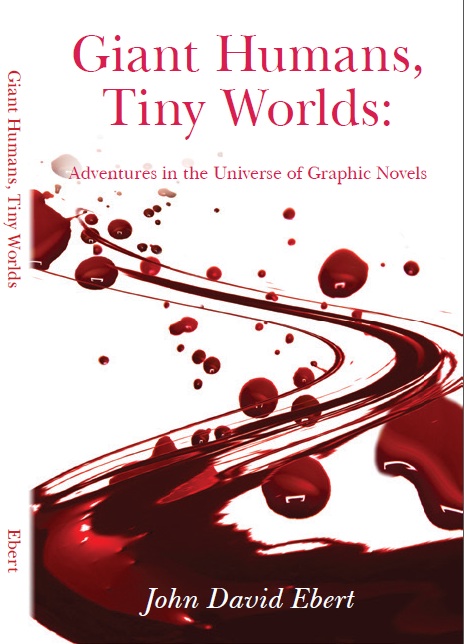This essay is excerpted from Giant Humans, Tiny Worlds: Adventures in the Universe of Graphic Novels. In this book, John David Ebert discusses 24 of the most popular graphic novels of all time, including “The Dark Knight Returns,” “Watchmen,” “Black Hole,” etc., looking for traces of the new imaginary significations with which the youth of today are shoring up the ruins of their own subjectivities.
From The Dark Knights Returns to The Killing Joke, and from there to Grant Morrison’s Arkham Asylum—written by him and drawn by Dave McKean in 1989—the character of Batman undergoes a series of compressions which have the effect of gradually flattening him out. In The Killing Joke, we saw how he had been transformed into a playing card, whereas in Arkham Asylum, he becomes a mere shadow, a signifier with even less informational content than a playing card. In Dave McKean’s rendering of him, Batman flits through the narrative as one shade among other shades, for McKean and Morrison have transformed him into an Egyptian khaibit, or shadow soul, which the Egyptians believed could detach itself from a person’s body and live its own independent life.
As the narrative opens, Commissioner Gordon informs Batman that the inmates have taken over Arkham Asylum, and Joker is on the phone demanding that Batman join them. He has hostages, one Dr. Ruth Adams, a therapist, and a Doctor Cavendish, the administrator. When Batman arrives, the Joker tells him he must play a game of hide and seek with them, or he will start killing hostages. To make his point, he shoots a security guard through the head. Batman then disappears into the labyrinthine interior of Arkham House where he encounters its various spooky inhabitants: Clayface, Doctor Destiny, Killer Croc, Maxie Zeus and Scarecrow. They are all inhabitants, moreover, who have been placed into Arkham House by Batman himself.
Like Alan Moore’s The Killing Joke, this is a narrative that is not about Gotham City at all, for Arkham House is a Foucauldian institution of exclusion. It is like those various systems of confinement that Foucault discusses in his books, beginning with the leprosaria of the Middle Ages which, during the Great Confinement of the 17th century were done away with by the advent of the Hopital General, into which was dumped, not only the mentally ill, but all of society’s undesirables, including vagrants, the unemployed, paupers and beggars. Later, near the end of the 18th century, as the sovereign age gave rise to the disciplinary society, the asylum was born, and the mentally ill were set free from their chains at places like Bicetre. Now they were no longer prisoners but rather patients with nervous illnesses such as hysteria and psychosis. In other words, they were no longer part of a random collective assemblage of the unwanted, but were subjectivized via the institutional processes as subjects of enunciation unto themselves.
But to identify these mentally ill patients and remove them from the metabolism of the social order requires a kind of Maxwellian Demon to reverse entropy by separating out the active, hot particles, from the slow-moving cool ones, and in the eighteenth and nineteenth centuries, it was of course medical doctors such as Tuke and Pinel who performed this function. In the universe of Gotham City, however, it is Batman who now plays this role, for it is he himself who, as immune cell, identifies those who constitute threats to the city’s order and reverses its entropy by taking such disordering elements as the Joker or Scarecrow and setting them aside into the little box of Arkham House as the official institution of confinement for Gotham’s undesirables.
In doing so, Batman has created a classical analogue for the Underworld, for the Underworlds of traditional societies are populated not just with criminals and sinners, but also with the gods and demons of previous social orders which have been conquered and assimilated through the various processes of acculturation. The demons in Milton’s Hell were all once pagan divinities, just as those of the Babylonian Underworld were once Sumerian deities. The unsavory inhabitants of Arkham House are not there because they are mentally ill, but because, as mythical entities, they pose a threat to the rationalist order of Gotham City. And within the city itself, amidst its ordered grid of machines and technological apparatuses, such masked apparitions stand out like the revelers of a James Ensor painting, so they are relatively easy for Batman to spot. But what Grant Morrison in Arkham Asylum asks us is this: what if, now, we place Batman himself inside the very Underworld of Arkham that he has created? Is it still so easy to spot the elements of the set that don’t belong?
For Batman, too, is a mythical archetype, and in this respect, he doesn’t mesh well with Gotham’s social order, either. He, too, is a figure out of ancient (Mayan) myth and legend, and on the inside of Arkham House, he simply blends in and disappears, becoming one shadow among many. After all, he too is the victim of a psychosis, for he is a vigilante who identifies himself with an ancient Bat god.
For the Egyptians, the khaibit, or shadow soul, was but one component of the subtle body, which included other elements like the ka and the ba, the ren and the khu, etc. etc. But by the time of the Greeks, the figures of the underworld had become shadows only, and that is how Homer portrays them in The Odyssey: as twittering shades without life or effective substance of any kind. In Morrison’s narrative, Batman himself has become one of these twittering shades, but now, unlike Homer’s protagonist or even Dante’s, he is unrecognizable as anything but a shade. In other words, he fits in very well. Thus, the terror that Batman experiences on the inside of Arkham House is the fear of the loss of his own unique identity amongst all these other shades who threaten to dissolve and erode him as a subject of enunciation and to make him a mere component in the larger collective assemblage of the mad. It is the fear of the loss of his personal identity that terrifies him here, as in fact, it does to so many of the inhabitants of our world cities today. The ones who react against the social order with violence, such as the various spree killers, are precisely the ones who are most afraid that their identities are in danger of being washed away by the flood of signifiers. Like the protagonist of Peter Shaffer’s play Equus, who can only speak in advertising jingos, the fear of the loss of identity is a very real one in an age of signifier overload.
Morrison, in Arkham Asylum, also tells a parallel story of the history of the founder of Arkham House, one Amadeus Arkham whose mentally ill mother had begun to have visions of a terrifying giant bat that would come and torment her. When, one night, Amadeus himself sees this vision of hers, he cuts her throat with a straight razor to put her out of her misery, but vows vengeance against the bat. In the present time line of the narrative, as Batman emerges from his night sea journey through Arkham’s labyrinth and its monsters, he encounters Richard Cavendish, the administrator who had been one of Joker’s hostages, but who is now threatening to cut the throat of Ruth Adams, the therapist. Cavendish explains this entire back story of Amadeus Arkham to Batman, and then insists that he is continuing where Amadeus left off. It was Cavendish who allowed the patients to take over as an attempt to lure Batman to the asylum, for Cavendish believes Batman to be the bat that troubled Amadeus’s mother. But Ruth Adams manages to twist free just as Cavendish attempts to strangle Batman, and she cuts his throat. The Joker and Two Face then allow Batman to leave after a flip of the coin, but they tell him that if the “asylum out there” ever becomes too much for him, there is always a place for him at Arkham. Batman is now saddled with the uncomfortable knowledge that in Arkham House, unlike in Gotham where he is regarded as a freak, he has found a place where he belongs.
Batman is a type of superhero which I will call The Immunologist, a pedigree that goes way, way back through the history of mythology. Beowulf, as the bear hero who defends the hall of Heorot against monsters like Grendel is one such example; as was Gilgamesh long before him (whose animal vahana was the lion, as it later became that of Hercules) whose job was to defend the city of Uruk against nightmare monsters like the Giant Taurus Bull that Inanna lets loose upon the city; or Digenis Akritas who, in the ninth century Byzantine epic of the same name, patrols the border of the Byzantine Empire along the Upper Euphrates to keep Arabs out. Such heroes are the immune cells of their respective cities and societies, and Batman is only his most recent incarnation.
But from reading Arkham Asylum, one gets the impression that it wouldn’t…take…much to tilt Batman over from the side of immunologist to antigen precisely because, in order to effectively recognize and battle figures of the archaic night world like the Joker and Killer Croc and Two Face, he must already have some component of their insanity dwelling within him like the mitochondrial DNA that has its own program in our cells that is completely different from the mother line of all our other DNA. That chaos element that he bears within him is necessary, for only the priest who sins can recognize the same syndrome in those he saves, but it must be kept carefully contained, since it functions like a psychosis that is never quite allowed to emerge into its full fury. If it were, and if it did, then Batman would be swept off the razor’s edge that he so carefully treads upon, to be washed away by the currents of insanity below. The Immunologist would then become part of an auto-immune disease that would begin to eat away at the somatic corpus of Gotham, which would perhaps, one fine day, grow dark (as so many of our coastal cities will be doing in about a century from now).
Immunology is a tricky business.















